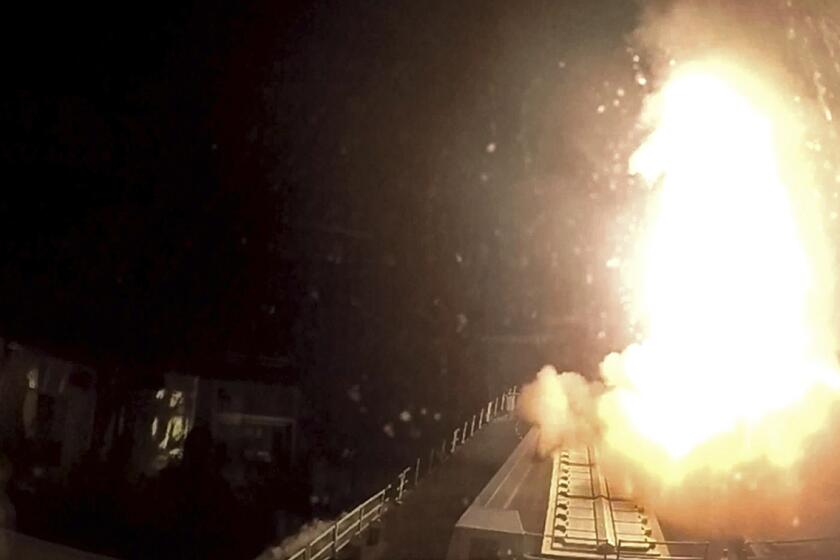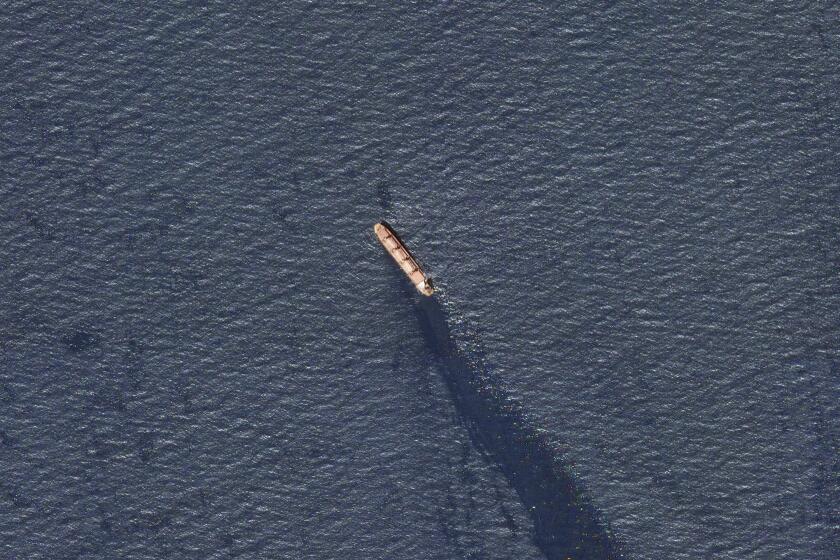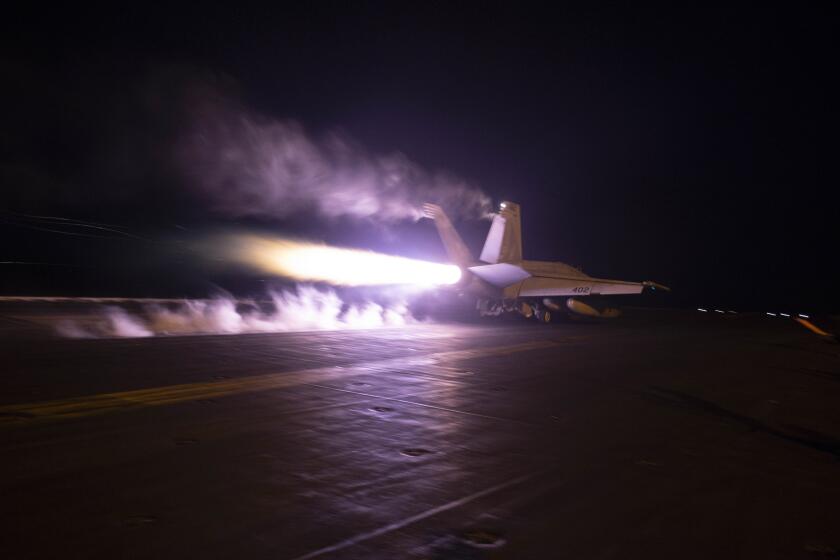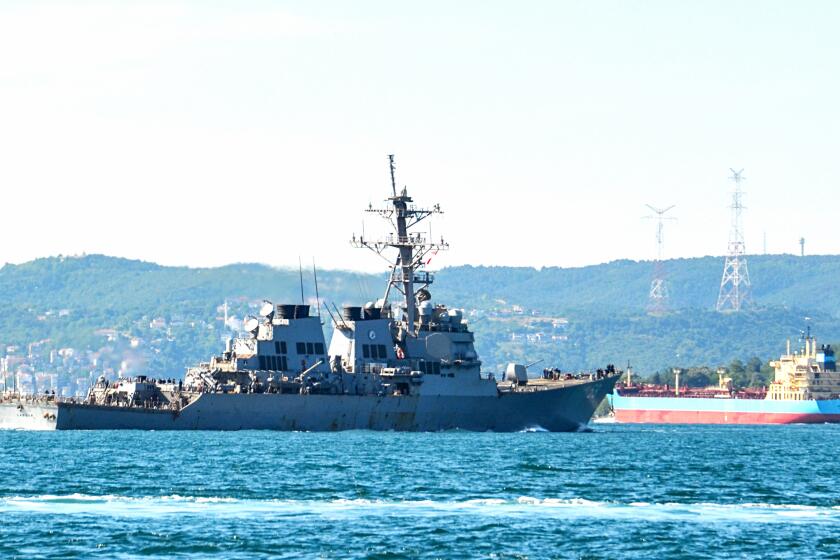Yemenâs Houthis claim to have hypersonic missile, report says, possibly deepening Red Sea crisis

DUBAI â Yemenâs Houthi rebels claim to have a new hypersonic missile in their arsenal, Russiaâs state media reported Thursday, potentially raising the stakes in their ongoing attacks on shipping in the Red Sea and surrounding waterways against the backdrop of Israelâs war on Hamas in the Gaza Strip.
The report by the state-run RIA Novosti news agency cited an unnamed official and included no evidence for the claim. It comes as Moscow maintains an aggressively counter-Western foreign policy amid its grinding war on Ukraine.
However, the Houthis have for weeks hinted about âsurprisesâ they plan for the battles at sea to counter the United States and its allies, which have so far been able to down any missile or bomb-carrying drone that comes near their warships in Mideast waters.
Meanwhile, Iran and the U.S. reportedly held indirect talks in Oman, the first in months amid their long-simmering tensions over Tehranâs rapidly advancing nuclear program and attacks by its proxies.
Iran is claiming to have developed a hypersonic missile capable of traveling at 15 times the speed of sound and therefore harder to intercept.
Iran, the Houthisâ main benefactor, claims to have a hypersonic missile and has been providing the rebels with the missiles they now use. Adding a hypersonic missile to their arsenal could pose a more formidable challenge to the air defense systems employed by the U.S. and its allies, including Israel.
âThe groupâs missile forces have successfully tested a missile that is capable of reaching speeds of up to Mach 8 and runs on solid fuel,â a military official close to the Houthis said, according to the RIA report. The Houthis âintend to begin manufacturing it for use during attacks in the Red Sea and the Gulf of Aden, as well as against targets in Israel.â
Mach 8 is eight times the speed of sound.
Hypersonic weapons, which fly at speeds higher than Mach 5, could pose crucial challenges to missile defense systems because of their speed and maneuverability.
Ballistic missiles fly on a trajectory in which anti-missile systems like the U.S.-made Patriot can anticipate their path and intercept them. The more irregular the missileâs flight path, such as a hypersonic missile with the ability to change directions, the more difficult it is to intercept.
Yemenâs Houthi rebels have fired their largest barrage of drones and missiles on shipping in the Red Sea, prompting the U.S. and British navies to respond.
China is also believed to be pursuing the weapons, as is the United States. Russia claims it has already used them.
In Yemen, Abdul Malik al-Houthi, the Houthi rebelsâ secretive supreme leader, boasted about the rebelsâ weapons efforts at the end of February, saying: âWe have surprises that the enemies do not expect at all.â
A week ago, he similarly warned: âWhat is coming is greater.â
âThe enemy ... will see the level of achievements of strategic importance that place our country in its capabilities among the limited and numbered countries in this world,â Al-Houthi said, without elaborating.
After seizing Yemenâs capital, Sana, in 2014, the Houthis ransacked government arsenals, which held Soviet-era Scud missiles and other arms.
As the Saudi-led coalition entered Yemenâs conflict on behalf of its exiled government in 2015, the Houthisâ arsenal was increasingly targeted. Soon â and despite Yemen having no indigenous missile manufacturing infrastructure â newer missiles made their way into rebel hands.
Israel intercepts a separate attack near Eilat, as the suspected missile attack by Yemenâs Houthi rebels set a ship ablaze in the Gulf of Aden.
Iran long has denied arming the Houthis, likely because of a years-long United Nations arms embargo on the rebels. However, the U.S. and its allies have seized multiple arms shipments bound for the rebels in Mideast waters. Weapons experts as well have tied Houthi arms seized on the battlefield to Iran.
Iran also now claims to have a hypersonic weapon. In June, Iran unveiled its Fattah, Persian for âConqueror,â missile, which it described as being hypersonic. It described another as being in development.
Iranâs mission to the U.N. did not respond to a request for comment Thursday, nor did the U.S. Navyâs Bahrain-based 5th Fleet, which patrols Mideast waterways.
Israelâs military â which also has come under Houthi fire since the war against Hamas erupted on Oct. 7 when Hamas-led militants attacked Israel, killing 1,200 people and taking 250 others hostage â declined to comment.
Also Thursday, the Financial Times reported that the U.S. and Iran held indirect talks in Oman in January that the Americans hoped would curtail the Red Sea attacks. The last known round of such talks were held last May.
The U.S. and Britain struck Houthi targets in Yemen after a surge in attacks by the Iran-backed militia group on ships in the Red Sea and Gulf of Aden.
Iranâs state-run IRNA news agency indirectly acknowledged the talks but insisted they were âmerely limited to negotiations on lifting anti-Iran sanctions.â
The U.S. State Department did not deny the January talks took place in a statement to the Associated Press, saying: âWe have many channels for passing messages to Iran.â
âSince Oct. 7, all of [the communications] have been focused on raising the full range of threats emanating from Iran and the need for Iran to cease its across-the-board escalation,â it added.
The Houthis have attacked ships since November, saying they want to force Israel to end the war in Gaza, which has seen over 31,000 Palestinians killed in the besieged strip, according to Palestinian authorities. The ships attacked, however, have increasingly had little or no connection to Israel, the U.S. or other nations involved in the war.
But the assaults have raised the profile of the Houthis, whose Zaydi people ruled a 1,000-year kingdom in Yemen up until 1962. Adding a new weapon increases that cachet and puts more pressure on Israel after a cease-fire deal failed to take hold in Gaza before the Muslim holy month of Ramadan.
Yemenâs Houthi rebels fired a missile, striking a U.S.-owned ship, less than a day after they targeted an American destroyer in the Red Sea.
Earlier in March, a Houthi missile struck a commercial ship in the Gulf of Aden, killing three of its crew members and forcing survivors to abandon the vessel. It marked the first fatal attack by the Houthis on shipping.
Other recent Houthi actions include an attack last month on a cargo ship carrying fertilizer. The ship, the Rubymar, later sank after drifting for several days.
A new suspected Houthi attack targeted a ship in the Gulf of Aden on Thursday, but missed the vessel and caused no damage, the British militaryâs United Kingdom Maritime Trade Operations center said.
Fabian Hinz, a missile expert and research fellow at the International Institute for Strategic Studies, said he wouldnât be surprised if Iran transferred a new, hypersonic weapon to the Houthis. However, the question is how maneuverable such a weapon would be at hypersonic speeds and whether it could hit moving targets, like ships in the Red Sea.
âI wouldnât exclude the possibility that the Houthis have some system that has some maneuvering capability to some extent,â Hinz said. âIt is also possible for the Iranians to transfer new stuff for the Houthis to test it.â
Gambrell writes for the Associated Press.
More to Read
Sign up for Essential California
The most important California stories and recommendations in your inbox every morning.
You may occasionally receive promotional content from the Los Angeles Times.















